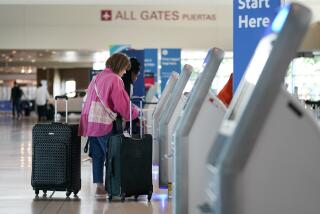Getting the Molasses Out at FAA : Wisest Reforms Don’t Include Creation of a New Agency
With the number of passengers traveling by air almost doubling since airline deregulation in 1978, and with near-collisions and traffic-controller errors mounting, the American public is rightly concerned about the state of our air transportation system.
A growing number of critics believe that the bureaucracy of the Federal Aviation Administration and its umbrella agency, the Department of Transportation, is too cumbersome to keep pace with growth in the aviation industry. A variety of proposals have been put forward: One is to remove the FAA from the Department of Transportation; a second is to create a nonprofit, user-owned corporation to run the air traffic system; a third would take the Aviation Trust Fund out of the federal budget process to provide a more secure source of funding for FAA needs.
I believe that shifting responsibility from one bureaucracy to another will not result in a safer or more efficient air traffic control system. Removing the FAA from the Transportation Department will not result in an agency more responsive to the changing needs of the aviation system. The FAA has always had a bureaucratic culture of its own, separate from the transportation secretary’s office and resistant to any outside interference.
A separate agency might more easily make changes in air traffic control operations--by expanding its capacity to handle more planes, for example--but its history before it was a part of the Transportation Department did not show it to be any more willing to issue safety regulations that burden the industry. I agree with Secretary James H. Burnley’s testimony before the Senate Commerce Committee: “Any time you have regulated interests telling Congress they need less oversight from those charged with regulating them on safety matters, healthy skepticism is in order.”
I have an even greater concern about a private corporation running the air traffic control system. We need to recognize that operating control towers, allocating the public airspace and issuing air safety rules are necessary and legitimate governmental functions. For example, the military uses 15% of the services of the air traffic control system. Controlling landings at crowded airports must be based on safety, not profits, and certainly no private entity owned by the airlines can be expected to independently regulate compliance with noise-abatement and environmental statutes, or to impose stiff penalties on the airlines for violations of safety rules.
This doesn’t mean that reform of the FAA is not needed. Clearly there are areas that need to be addressed. For example:
- The FAA and Transportation Department system of procurement is too slow and painful. Equipment purchased to modernize the air traffic control system is often obsolete by the time it is delivered and installed. The FAA must be able to purchase new equipment quickly and should keep up with existing technology, often purchasing off-the-shelf items rather than putting off improvements until a new, more perfect technology is completed.
- The FAA is hamstrung by civil-service rules that prohibit it from paying cost-of-living differentials to employees who live in high-cost areas. As a result, it is often difficult to obtain qualified controllers for busy airports like O’Hare in Chicago, Logan in Boston and La Guardia in New York. Equally troubling is the insufficient number of fully trained qualified controllers. Ideology and old scores should not prevent the Administration from giving serious consideration to rehiring many of the Professional Air Traffic Controllers Organization members fired in 1981.
- As chairman of the House Budget Committee in the 1970s, I used to believe that all federal funds should be in a unified budget. The events of the last seven years have changed my mind. The Aviation Trust Fund, paid for by taxes on airline fuel and airline tickets, was designed to pay for air traffic control and for airport improvements. Unfortunately, we now see the trust fund being used in the budget process as a way to offset the deficit. This has meant that spending from the trust fund is usually delayed and often is less than is needed. We should remove the trust fund from the overall limits on the federal budget so that user fees go for the purposes designated.
The above reforms are being addressed by Congress in the current debate over the future of our air transportation system. The result should be a governmental process that will respond more quickly to changes in the aviation industry and continue to handle the growing amount of traffic in a safe and efficient manner. In reaching that result, we have to identify the specific problems in the system that hinder innovation and develop policies to address them. We also have to recognize that change for change’s sake can produce more harm than good.
More to Read
Sign up for Essential California
The most important California stories and recommendations in your inbox every morning.
You may occasionally receive promotional content from the Los Angeles Times.










